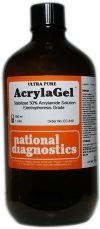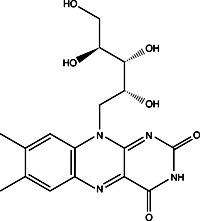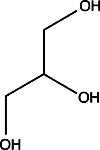Electrophoresis
AcrylaGel
$79.50 – $142.00
Catalog Number: EC-810
- Stabilized Acrylamide Solution
- Deionized and Pre-filtered
- Aldehyde and Acrylic Acid-Free
- Certified RNase and DNase Free
- Stabilized for a Two Year Shelf Life
Description
Catalog Number: EC-810
- Stabilized Acrylamide Solution
- Deionized and Pre-filtered
- Aldehyde and Acrylic Acid-Free
- Certified RNase and DNase Free
- Stabilized for a Two Year Shelf Life
AcrylaGel is a ready-to-use, 30% acrylamide solution in distilled/deionized water. AcrylaGel contains 300 grams of acrylamide per liter of solution. Acrylamide in its crystalline form is subject to self-polymerization, and as a result the purity and consistency of polymerized AcrylaGel is superior to that obtainable with powdered acrylamide.
AcrylaGel can be crosslinked with Bis-AcrylaGel, a ready-to-use, 2% solution of methylene bisacrylamide with the same advantages as the AcrylaGel acrylamide solution. However, any powdered crosslinking reagent can be used with AcrylaGel.
AcrylaGel is stable for 24 months when stored tightly capped in a dark area at room temperature (20ºC).
Additional information
| Weight | 4.8 lbs |
|---|---|
| Dimensions | 7 × 7 × 14 in |
Protocol
Procedure
Mix Gel Solution
Calculate how much AcrylaGel and Bis-AcrylaGel you need to make your gels by using the formulas below. Bring up to the desired final volume with your usual buffers and distilled water.
Va = (A)(Vt)/30
Vb = (A)(C)(Vt)/200
where,
Va = Volume of AcrylaGel to be used (ml),
Vb = Volume of Bis-AcrylaGel to be used (ml),
Vt = Total volume of gel casting solution desired (ml),
A = % acrylamide desired in gel,
C = % crosslinker desired
EXAMPLE: To make 100ml of a 10% acrylamide gel 2.7% crosslinked with bis, calculate the volume to be added as follows:
Va = (10) (100)/30 = 33.3ml AcrylaGel
Vb = (10) (2.7) (100)/200 = 13.5ml Bis-AcrylaGel
Add APS and Cast Gel
Add 1.0ml of 10% (w/v) FRESHLY PREPARED ammonium persulfate for every 100ml of gel casting solution. Swirl gently to mix. Add 0.1ml of TEMED for every 100ml of gel casting solution. Swirl gently to mix. Pour the solution into the gel casting cassette.
The gel should begin to set in 10-20 minutes.
Safety Overview
Safety Summary (see MSDS for complete information before using product):
EMERGENCY OVERVIEW – IMMEDIATE HAZARD
- UV Shadowing
- Using PAGE to Determine Nucleic Acid Molecular Weight
- Uneven Staining
- The Polyacrylamide Matrix-Buffer Strength
- The Polyacrylamide Matrix
- The Mechanical and Electrical Dynamics of Gel Electrophoresis — Electrophoresis System Dynamics
- The Mechanical and Electrical Dynamics of Gel Electrophoresis – Ohm’s Law
- The Mechanical and Electrical Dynamics of Gel Electrophoresis – Intro and Sample Mobility
- The Electrophoresis Matrix
- The Agarose Matrix
- Staining Proteins Immobilized on Membranes
- Staining Protein Gels with Coomassie Blue
- SSCP Analysis
- Southern Blotting
- Smeared Bands
- Silver Staining Protein Gels
- Silver Staining DNA Gels
- Sanger Sequencing
- Sample Preparation for SDS-PAGE
- Sample Preparation for Native Protein Electrophoresis
- Sample Preparation for Native PAGE of DNA
- Sample Prep for Denaturing PAGE of DNA
- S1 Mapping
- Run Conditions in Denaturing PAGE
- RNA Mapping
- RNA Electrophoresis
- Ribonuclease Protection
- Restriction Digest Mapping
- Radioactive Emissions and the Use of Isotopes in Research
- Protein Fixation on Gels
- Primer Extension
- Preparing Denaturing DNA & RNA Gels
- Preparation of Denaturing Agarose Gels
- Preparation of Agarose Gels
- Pouring Sequencing Gels
- Post-Electrophoretic Visualization with Nuclistain
- PFGE and FIGE
- Peptide Mapping
- PCR Analysis: Yield and Kinetics
- PCR Analysis: An Examination
- Overview of Western Blotting
- Northern Blotting
- Native Protein Electrophoresis
- Native PAGE of DNA
- Multiphasic Buffer Systems
- Mobility Shift Assay
- Methylation & Uracil Interference Assays
- Method for Western Blotting
- Mechanism of Immunostaining
- Mechanism of Immunostaining
- Measuring Molecular Weight with SDS-PAGE
- Maxam & Gilbert Sequencing
- Manual Sequencing
- Isotachophoresis
- Isoelectric Focusing
- In Gel Enzyme Reactions
- Immunostaining with Alkaline Phosphatase
- Immuno-Electrophoresis / Immuno-Diffusion
- Horizontal and Vertical Gel Systems – Vertical Tube Gels
- Horizontal and Vertical Gel Systems – The Vertical Slab Gel System
- Horizontal and Vertical Gel Systems – The Horizontal Gel System
- Homogeneous Buffer Systems
- Heteroduplex Analysis
- Guide Strip Technique
- Gel Preparation for Native Protein Electrophoresis
- Gel Preparation for Native PAGE of DNA
- Gel Electrophoresis of RNA & Post Electrophoretic Analysis
- Gel Electrophoresis of PCR Products
- Faint bands, low background
- Faint Bands, High Background
- Ethidium Bromide Staining
- Enzyme Linked Immunosorbent Assay (ELISA)
- Electrophoresis Buffers-Choosing the Right Buffer
- Electrophoresis Buffers–The Henderson-Hasselbalch Equation
- DNase I Footprinting
- DNA/RNA Purification from PAGE Gels
- DNA/RNA Purification from Agarose Gels – Electroelution
- Differential Display
- Denaturing Protein Electrophoresis: SDS-PAGE
- Denaturing Polyacrylamide Gel Electrophoresis of DNA & RNA
- Coomassie Blue Stain- Troubleshooting
- Conformational Analysis
- Casting Gradient Gels
- Buffer Additives-Surfactants
- Buffer Additives-Reducing Agents
- Buffer Additives-Hydrogen Bonding Agents
- Blotches on Gel
- Biological Macromolecules: Nucleic Acids
- Biological Macromolecules – Proteins
- Autoradiography
- Autoradiographic Enhancement with Autofluor
- Automated Sequencers
- Analysis of DNA/Protein Interactions
- An Overview of Northern and Southern Blotting
- Alkaline Blotting
- Agarose Gel Electrophoresis of DNA and RNA – Uses and Variations
- Agarose Gel Electrophoresis of DNA and RNA – An Introduction
- Activity Stains




